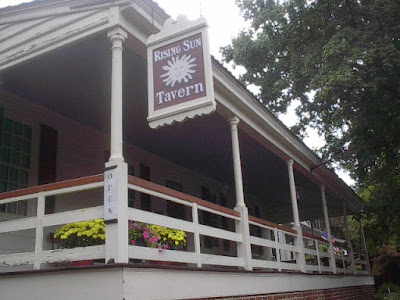Ross picked us up at the Farnham Estate outside Cavan City at the agreed upon time and our adventure began. Before we left the United States, Ross sent us a brochure with possible places that we might want to visit. We did actually visit a few of them but the main reason we wanted to have a guided tour was so that we could go to the townland that was the home to Kathy’s ancestors.

Ross brought us to what was the post office in this tiny little townland and then to the church where the family or at least relatives would have worshipped. We got out and walked around the cemetery and got the feel of what this townland was like. In all honesty, it probably hasn’t changed a whole lot since her ancestor left to come to America.

Our next stop was Cloughoughter Castle. It is located on an island in Lough Oughter. It was most likely built in the 11th century by William de Lacy who was the Lord of Meath. It was, however, the stronghold of the O’Reilly’s (O’Raghallaigh) who were the lords of East Breifne. It is best remembered as the place where Irish general Owen Roe O’Neill died in 1649 and was the last Irish Garrison to surrender to Cromwell in 1653.
It is a very photogenic location, unfortunately, the weather decided not to cooperate and our photos are not as spectacular as they should be. You do need to be able to walk on the uneven ground since you park a little distance away and walk in. If you like to see historic ruins this will fit the bill nicely.

We headed off to see a thatched roof cottage. We told Ross we would like to see one or at least Kathy wanted to see one. I have seen my share of thatched cottages in England. He took us to an art cooperative which is located in as pretty a cottage as anyone could wish for. Another item off the bucket list.

St Keiran’s Well was our next stop. It is one of the holiest wells in Ireland and dates back to pagan times. It is a steep climb up to the actual shrine, we felt a bit like mountain goats. I did get some of the water to bless myself since it seemed like the right thing to do.
By this time I was getting peckish so we headed to Kells to see the remains of the abbey and to have a bit of lunch. Be aware that meals and even meal stops are not scheduled and I laughingly told Ross he had a cast-iron bladder.

The Abbey at Kells was where the famous Book of Kells was created. Not much is left but the round tower is visible from a distance and it is located within the grounds of a Church of Ireland Church.

We went into the Herdfort Arms Hotel to the Therese Café and had a simple Carvery lunch cafeteria style. I had a bowl of great soup with a grainy roll and Pavlova for dessert, this army travels on its stomach!!

Our next stop was a folly. It is a great lighthouse which when you consider how far away the ocean is, makes you realize why it is a folly. We had seen it as we drove through Kells headed for the Farnham Estate and were curious to see it.

Knowing that Kathy’s Irish Cavan family name was Sheridan, Ross took us the ancestral family home of General Richard Sheridan. It is rather ramshackle these days but Kathy was delighted and even chose to risk her life by going inside. Since this is private property that wasn’t the best idea but what the heck, it is not like we were ever coming back here!!

Ross next suggested that we go to see some of the ancient court tombs. Trust me when I tell you, we would never have found the one he took us to, it is definitely on a less than B Road. Fascinating stuff but again, you need to be able to go over fences and walk on very uneven ground, not for the faint of heart.

Our last stop of the day was at twilight at the magnificent Abbey ruin at Drumlane. We spent quite a while walking through the ruins but we were equally as fascinated by the rather unique cows that were pastured along the trail we walked to get into the ruin.

By now we were quite exhausted, it had been a long day jam-packed with all the things we wanted to do and a few that Ross thought we should see and it was one of the most perfect days I have ever spent in Ireland.
Ross is no longer operating his tour company so you will need to find another tour company but I am sure he is not the only one available.

























